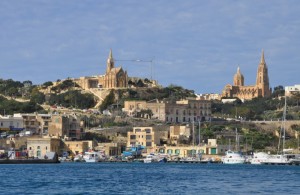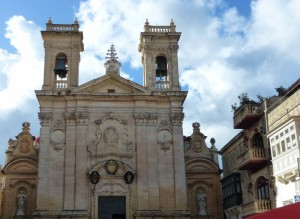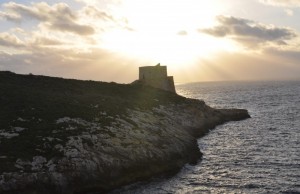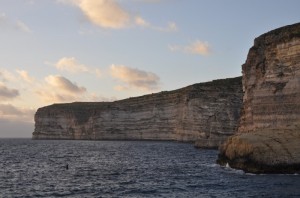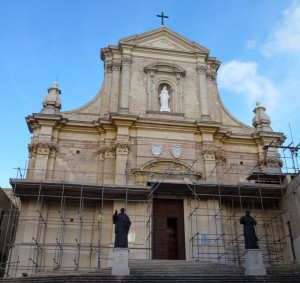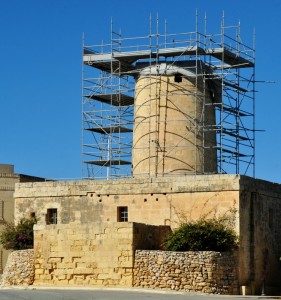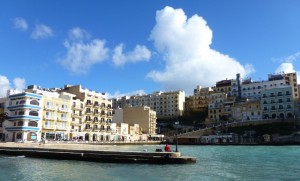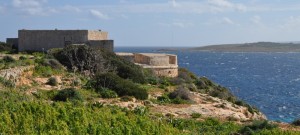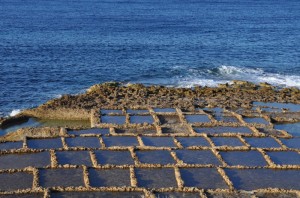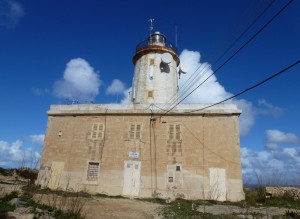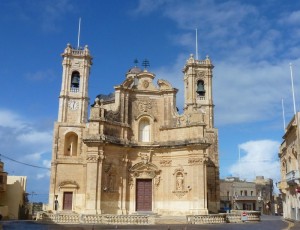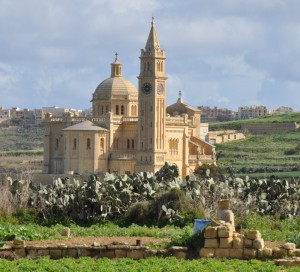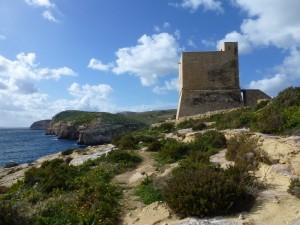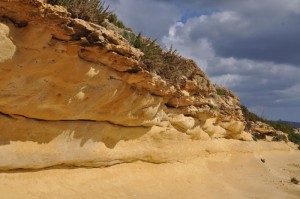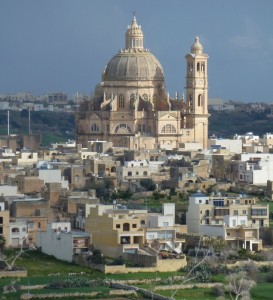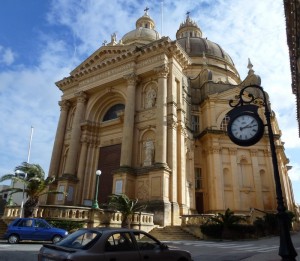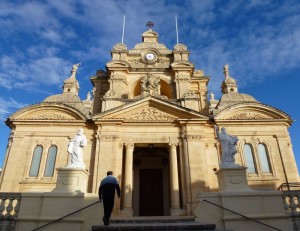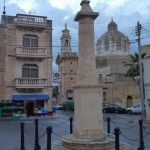Mediterranean Island Hopping: Gozo & Comino February 4 – 8
Gozo is the second largest island in the archipelago with an area of 67 square kilometres (14km long and 7.25km wide) and some 30,000 inhabitants (known as Gozitans) in 17 villages. It is known for its beautiful countryside and coastal cliffs, secluded beaches and above all the Ggantijiz temples, the world’s oldest free-standing structures. Despite its small size and population, it has 46 churches.
Ferries leave for Mgarr, Gozo from Cirkewwa, Malta once every 30 minutes. The journey takes 25 minutes and a return ticket only cost €4.65. The island has a comprehensive bus service covering all the villages. Like Malta, one can get a day pass for €2.60 and buses running from Victoria to villages roughly once an hour.
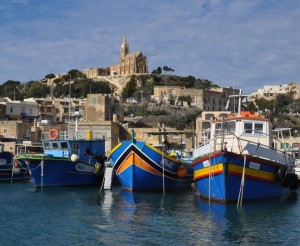 |
I spent two nights in Xiendi and three nights in Marsalforn, visited nine out of the 17 villages, four museums and churches and had five short walks. In addition, I took a side trip to Comino, the third largest island. I did not do too much by my standard but I had a blissful and most enjoyable time.
February 4 Monday
I took a ferry to Gozo at noon and met Yan and Poh, a young couple from Singapore. They had booked the same hotel and we made our way to Hotel Xiendi together. Xiendi is a small but popular bay with both locals and visitors. There are three hotels and numerous holiday flats. I had a huge apartment for €20. But I find the flat dark, cold and without a view.
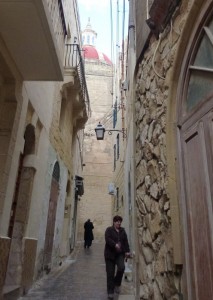 |
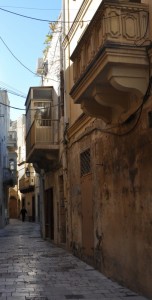 |
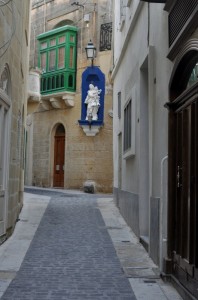 |
I took a bus back to Victoria at 3pm and spent two hours in the capital city. I went to the citadel which was first fortified during the Bronze Age. It is impressive dominating the skyline. With my Heritage Malta pass, I went to the Gozo Archaeology Museum and Folklore Museum. They have few exhibits of real interest. But the setting is nice and the information well presented. I did not enter the Cathedral which has been turned into a museum and requires an entry fee of €3.50.
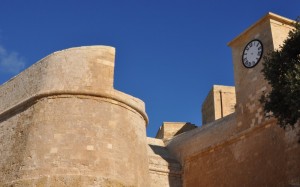 |
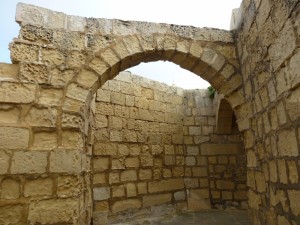 |
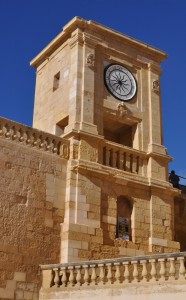 |
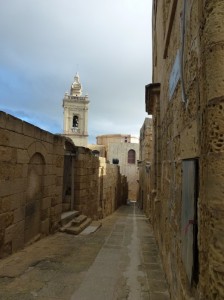 |
I strolled happily around it-Tokk (the Independent Square) and went to the basilica. As I had a kitchen, I brought a fresh pork sausage, tomatoes and a bottle of Gozo Merlot for less than €7. I had a delicious dinner. The sausage was too salty and I could not stop drinking water. I was kept awake because of noises and bugs/insects. I was badly bitten!
February 5 Tuesday: Hop-on & Hop-off bus tour
With a day bus pass, I could visit all the attractions on the island. But in order to sample the hop-on and hop-off sightseeing bus service, I decided to buy a ticket at a reduced price of €8 (the normal price is €15) from an agent. Before hopping on the first bus at Victoria at 10am, I used Heritage Malta pass to visit to the Old Prison in the citadel.
First stop: the iconic and photogenic Azure Window and Dwejra Inland Sea. As the wind was strong, the Inland Sea was dead with all boats locked away in the boat sheds! I had no chance to see the Azure Window and the cliffs in a boat. What a pity!
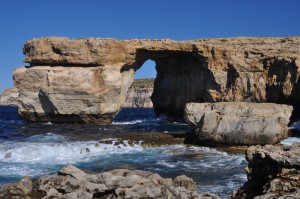 |
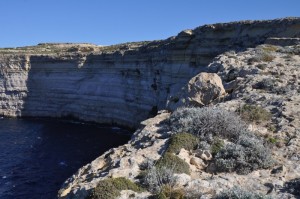 |
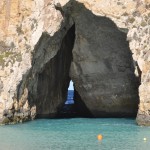 |
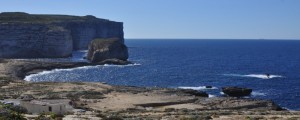 |
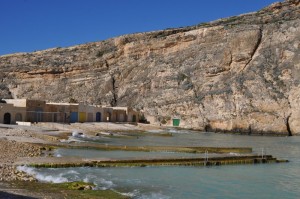 |
Second stop: Ggantija Temples (c.3600-3000 BC) and Ta’ Kola windmill (1725) in Xaghra. The two temples were built side by side enclosed within a single massive boundary wall and sharing the same façade. This complex was in use for about 1000 years and later became a cremation cemetery during the Early Bronze Age (2500-1500 BC). There are some huge blocks measuring over five metres in length and weighing several tonnes.
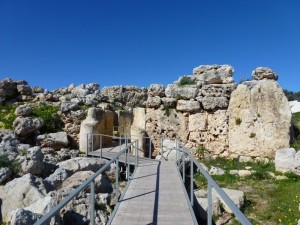 |
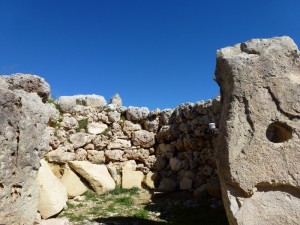 |
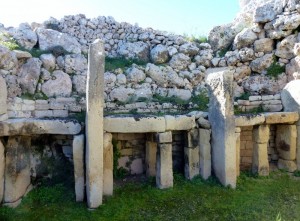 |
Third stop: red sand Ramla Bay and Calypso’s Cave. I spent almost an hour and a half walking along the slopes and coastal cliffs above the beach.
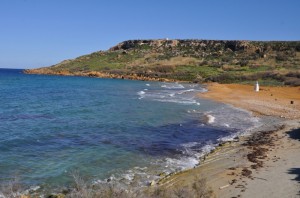 |
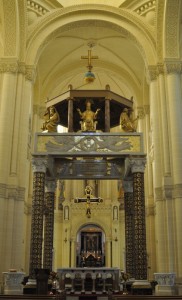 |
It was 3pm when I hopped on the bus again. The driver said the tour would end at Mgarr and he would be going back to Victoria. As I wanted to visit the Ta Pinu Shrine, the driver kindly took me there. I had to return to Victoria using my day pass.
As it was not yet 5pm, I intended to take a ride to Marsalforn to check out the place before booking a hotel there. But I took the wrong bus and found myself in Xiendi before 5pm. I had no lunch and was happy to have an early dinner. I do not like pizza but had one at a pub (as it was the only thing available!). I was back in my room before 6:30pm. The place was dead without any sign of life! It’s time to leave Xiendi and I booked the next three nights with Calypso Hotel at Marsalforn.
February 6: Trekking in Comino and from Marsalforn to Victoria (4 hours; about 13km)
I joined Yan and Poh and took the ferry to Comino, the third largest island in the archipelago and paid a return ticket for €15. We arrived in Comino around 10:30am. The captain told us to be at the pier by 1pm.
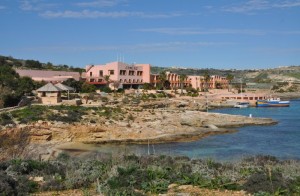 |
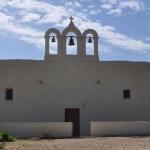 |
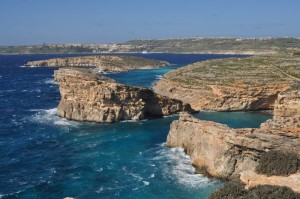 |
Comino with an area of 1.35 square kilometres is known for its tranquility and isolation. It has a permanent population of four residents. It is now a bird sanctuary and nature reserve. Visitors and nature lovers come here to walk, to see the Santa Marija Tower which stands 230ft above sea level on a steep slope surrounded by a thick rubble wall, the Blue Lagoon, the birds and the natural scenery.
Yan and Poh are both keen photographers. They spent most of the time on photo-taking in the Blue Lagoon. Though I had no map in hand, I vaguely remembered the topography and followed a walking path which took me round the island passing a tiny chapel, a huge abandoned construction site, St Mary’s Battery built in 1716 and Santa Marija Tower.
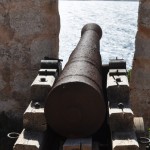 |
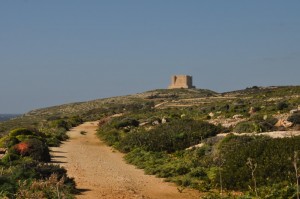 |
St Mary’s Battery was built in 1716 when other batteries were constructed around the coastline of mainland Malta. It is a semi-circular structure with four embrasures facing the sea. The Battery still houses two 24-pound iron cannons.
Santa Marija Tower standing 230ft above sea level on a steep slope surrounded by a thick rubble wall is impressive. It affords stunning views of Kemmunett (some rocks) and partial views of Blue Lagoon (I did not know it was the Blue Lagoon at that time). If I did not need to rush back, I would have taken the footpath above the cliffs which affords fantastic views of the Blue Lagoon.
The weather had changed. The Captain was anxious to get us safely back to Mgarr. The wind was strong and the sea was very rough. We had to grip tightly on the rail. I was relieved to get off the ferry at 1:30pm. I said good-bye to Yan and Poh and took my bus to Marsalforn at 2:52pm. While waiting for my bus, I sat at a café and had a coffee. People on the island spend considerable time waiting for buses! But they have no option unless they have a car.
I had a room with a balcony affording stunning views of the sea and the Zebbug village perching high on a plateau. I left the hotel at 4pm to see salt pans along the coast and planned to go to the Zebbug village for a drink before taking a bus back to Marsalforn. I missed the path leading to Zebbug as there is no road sign. I ended up walking all the way to Ghasri and then Victoria. I arrived at the Victoria bus station at 6pm and took a bus back to Marsalforn at 6:15pm. What a great day!
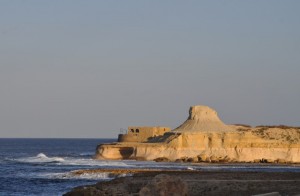 |
|
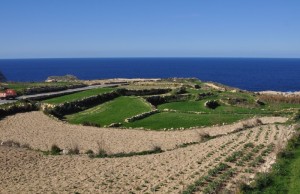 |
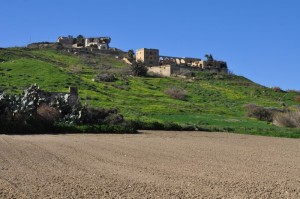 |
February 7 Thursday: Trekking Ghasri – Gordan Lighthouse – Gharb – San Lawrenz (3 hours; about 8km)
The northern shore of Gozo is known for its natural beauty. I took a bus to Ghasri and walked to the Gordon Lighthouse (1853) (which I saw on my walk the day before). It was so windy that I thought I might be blown off the cliff. I followed the road to Gharb, a sleepy village with a laid-back atmosphere. I later discovered that there is a free leaflet on the circular walk around the village of Gharb. When I asked the tourism office in Victoria about walks in Gozo, the staff did not give me this leaflet and simply told me to buy a book with details on the walks.
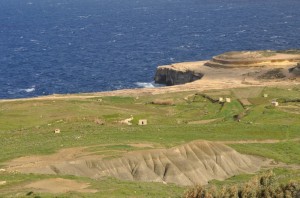 |
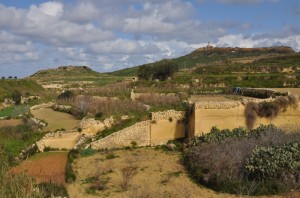 |
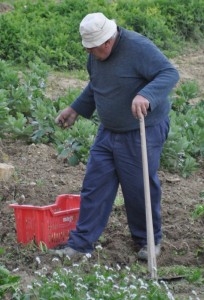 |
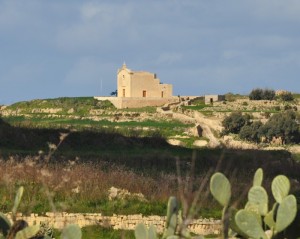 |
I walked leisurely and met no other trekker at all. I passed Ta’ Ghammar, crossed a bridge below which was once a quarry and reached Gharb. I was desperate to find a toilet but no café was open. The only place that was open was the Gharb Folklore Museum opposite the church. I asked the lady of the museum whether I could use the toilet. She told me to get a ticket for €3.50 so that I could use it for free. I had no option.
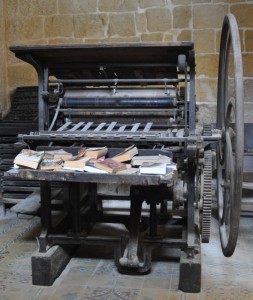 |
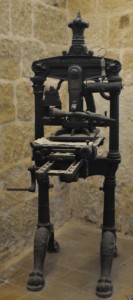 |
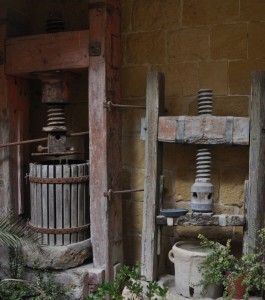 |
This private museum is housed in an 18th century historical house with 28 rooms filled with all sorts of stuff! The lady showed me around giving me detailed explanations on the exhibits. She said out of the 800 inhabitants in Gharb today, some 300 inhabitants are foreigners and properties are expensive. She offered me to stay in one of her flats for €15 a night.
I planned to go to St Dimitri, Gozo’s best known legendary spot first recorded in 1575. It is said that St Dimitri rescued a son of an old lady from slavery. But as signage is very poor or lacking, I could not find my way. A hailstorm arrived and was followed by rain. I had no raincoat or umbrella. There is no shelter in sight. I had no option and had to walk to Birbuba and then San Lawrenz hoping to find a shelter or bus on the way. Though the weather had improved slightly, I was still wet and cold when I got on a bus in San Lawrenz. Then I made my way back to the hotel.
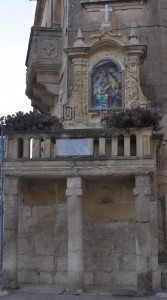 |
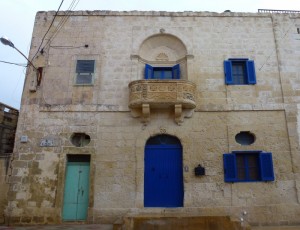 |
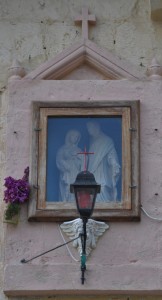 |
When I got off the bus around 2:30pm, I felt sharp pains around my hip and back. Is my old back pain problem coming back? I was scared but had to remain calm. I walked very slowly back to the hotel, took a hot bath, rest for the rest of the day hoping the problem would go away.
February 8 Friday: Trekking Ta’ Cence – cliffs – Mgarr ix-Xini Tower – Xewkija (4 hrs; about 12km)
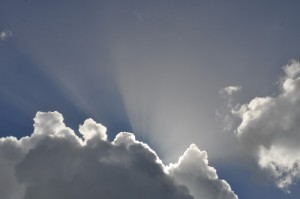 Today, I took a bus to Ta’ Cenc which has a famous 5-star hotel with spa. From there, I took a walk for an hour and a half to see the spectacular limestone cliffs of Gozo. Unfortunately, hailstorm and heavy showers arrived suddenly. Though I was better prepared with my rain jacket on, I still felt cold and did not like the ghastly wind. I went to the coffee shop and had a nice cappuccino. I met two Brits who are artists living on the island. They told me how fantastic life is on the life. I believe them as I love islands myself and the Maltese islands are lovely and most livable. Though they are small, they have fantastic natural scenery as well as 7000 years of history!
Today, I took a bus to Ta’ Cenc which has a famous 5-star hotel with spa. From there, I took a walk for an hour and a half to see the spectacular limestone cliffs of Gozo. Unfortunately, hailstorm and heavy showers arrived suddenly. Though I was better prepared with my rain jacket on, I still felt cold and did not like the ghastly wind. I went to the coffee shop and had a nice cappuccino. I met two Brits who are artists living on the island. They told me how fantastic life is on the life. I believe them as I love islands myself and the Maltese islands are lovely and most livable. Though they are small, they have fantastic natural scenery as well as 7000 years of history!
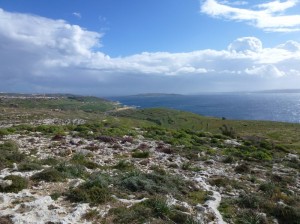 |
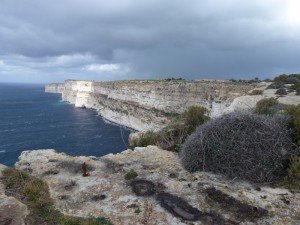 |
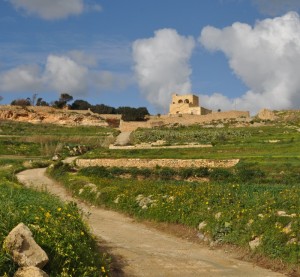 |
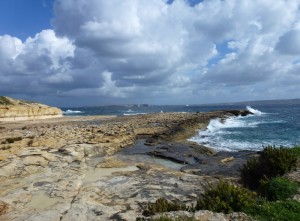 |
At noon, I left the hotel coffee shop and took the path from Ta’ Cenc to Mgarr ix-Xini Tower and then to Xewkija where I visited the St John the Baptist Church with a capacity of 3000 and a dome larger than that of St Paul’s Cathedral in London. I took a bus back to Victoria and had spaghetti with rabbit meat. Then I hopped on the bus leaving for Nadur at 4pm.
Nadu is famous its St Paul and St Peter Church and wild carnival (from February 8 evening to February 10). I went in the church and noticed there was a special service with some ten priests fully dressed in purple robes and several church boys. I later discovered it was actually a funeral service for a 75-year-old lady.
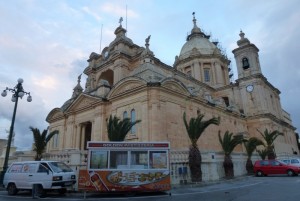 |
It was dark, wet and cold. Some vendors were busy setting up food stalls for the carnival. I wonder how many people would come out for the carnival in the rain. I returned to Marsalforn by bus and was back in my room before 6:30pm.



